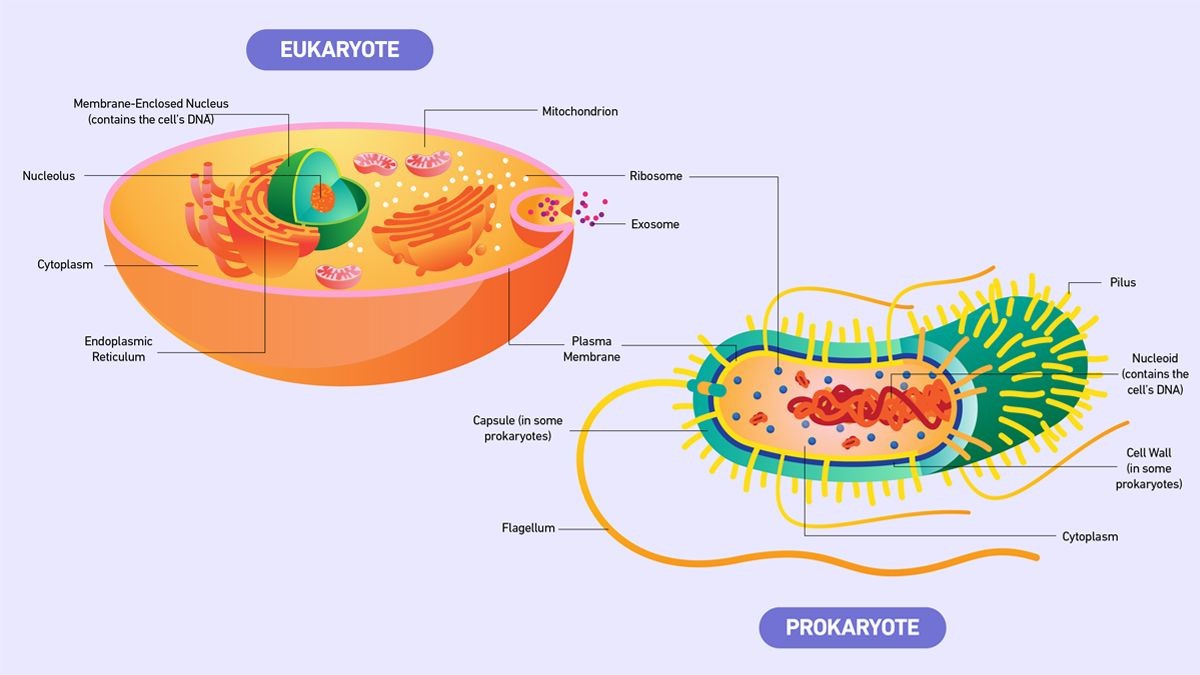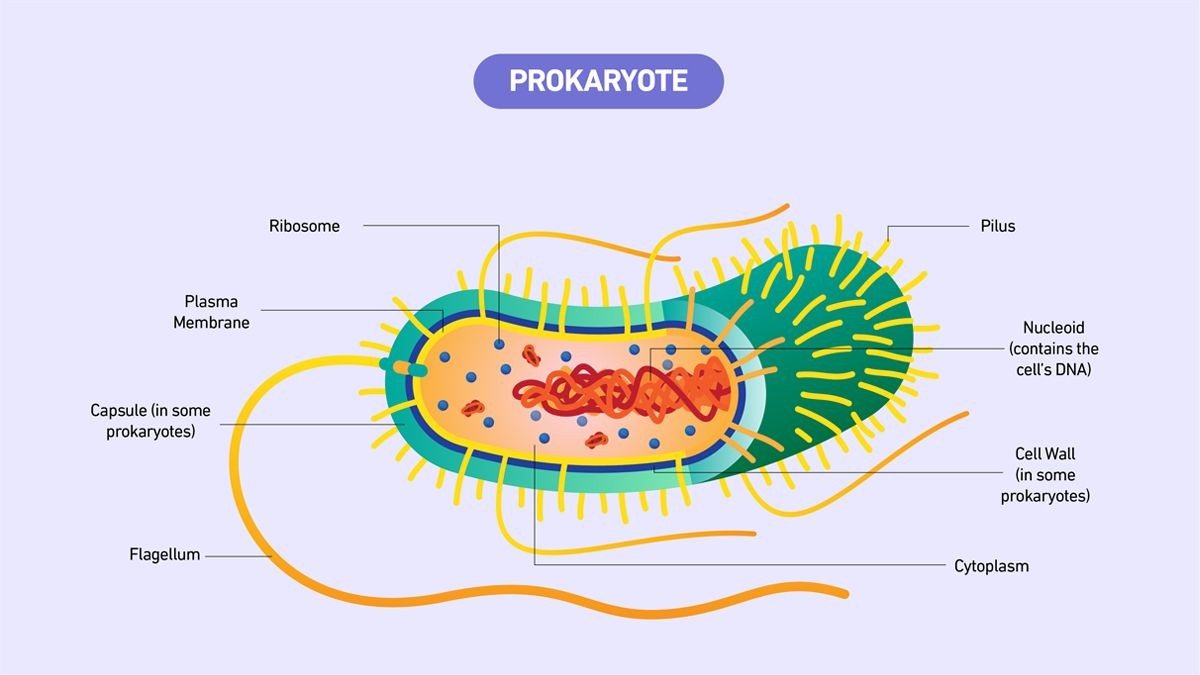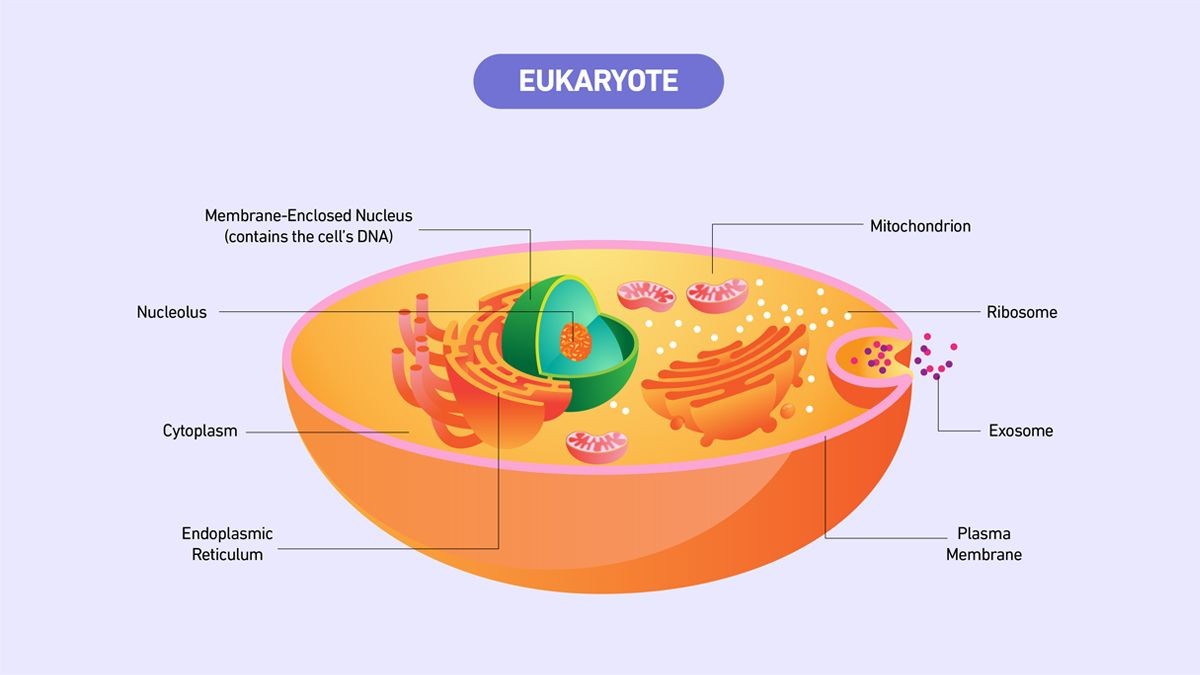Comparing a prokaryotic cell and a eukaryotic cell reveals fundamental differences in their structure and function, which COMPARE.EDU.VN elucidates, providing clarity for students, researchers, and anyone interested in biology. Understanding these cellular distinctions is crucial for grasping the complexities of life, from the simplest bacteria to the most complex multicellular organisms, impacting fields like medicine, biotechnology, and evolutionary biology. Explore the nuances of cellular biology with comprehensive insights into cell structure, gene expression, and evolutionary relationships.
1. Comparing Prokaryotic And Eukaryotic Cells: An Overview
Prokaryotic and eukaryotic cells represent the two primary types of cells found in living organisms. Prokaryotes, which include bacteria and archaea, are typically unicellular and lack a nucleus or other membrane-bound organelles. Eukaryotes, which comprise animals, plants, fungi, and protists, are often multicellular and feature a nucleus and various membrane-bound organelles that compartmentalize cellular functions. Understanding the evolutionary relationship, structural differences, and functional variations between these two cell types is fundamental to grasping the complexities of biology.
Current scientific understanding suggests that eukaryotes evolved from prokaryotes approximately 2.7 billion years ago. The endosymbiotic theory posits that eukaryotic cells arose when two prokaryotic cells formed a symbiotic relationship and merged. This process, known as endosymbiosis, is believed to have led to the development of membrane-bound organelles, such as mitochondria. The acquisition of mitochondria provided eukaryotic ancestors with sufficient energy to evolve into the more complex eukaryotic cells observed today.
However, recent research challenges this traditional view. A study from the University of Jena, published in mBio, identified prokaryotic bacteria capable of “eating” other cells. This finding contradicts the long-held belief that only eukaryotes could perform endocytosis, a cellular process in which substances are brought into the cell and form intracellular vesicles. These findings suggest a need to re-evaluate existing theories regarding the origin of eukaryotes.
The most significant distinction between prokaryotic and eukaryotic cells lies in the presence or absence of a membrane-bound nucleus. In eukaryotes, the nucleus houses the cell’s genetic information. In prokaryotes, DNA is bundled together in the nucleoid region, which lacks a surrounding membrane. Additionally, eukaryotes contain numerous other membrane-bound organelles, whereas prokaryotes do not. Another crucial difference is the structure and location of DNA. Eukaryotic DNA consists of multiple molecules of double-stranded linear DNA found in the nucleus, while prokaryotic DNA is often circular and located within the cytoplasm.
2. Key Similarities Between Prokaryotes And Eukaryotes
Despite their many differences, prokaryotic and eukaryotic cells share several fundamental features. These commonalities reflect their shared ancestry and the basic requirements for cellular life.
All cells, regardless of whether they are prokaryotic or eukaryotic, possess the following four characteristics:
- DNA: Deoxyribonucleic acid (DNA) serves as the genetic material, carrying the instructions for cell function and reproduction.
- Plasma Membrane: A plasma membrane, also known as a cell membrane, is a phospholipid bilayer that separates the interior of the cell from its external environment. It regulates the passage of substances into and out of the cell.
- Cytoplasm: The cytoplasm is the gel-like substance within the cell that contains various organelles and molecules. It is the site of many metabolic reactions.
- Ribosomes: Ribosomes are responsible for protein synthesis. They translate genetic information encoded in messenger RNA (mRNA) into proteins.
These shared features highlight the fundamental unity of life at the cellular level. Both prokaryotic and eukaryotic cells rely on these components to maintain their structure, function, and ability to replicate.
3. What Are The Key Differences Between Prokaryotes And Eukaryotes?
Prokaryotes and eukaryotes differ significantly in several important aspects, including structural organization, cellular complexity, and genetic material. These differences reflect their evolutionary history and the diverse roles they play in the biosphere.
| Feature | Prokaryote | Eukaryote |
|---|---|---|
| Nucleus | Absent | Present |
| Membrane-bound Organelles | Absent | Present |
| Cell Structure | Unicellular | Mostly multicellular; some unicellular |
| Cell Size | Typically smaller (0.1–5 μm) | Larger (10–100 μm) |
| Complexity | Simpler | More complex |
| DNA Form | Circular (often), linear plasmids and chromosomes sometimes found | Linear |
| Examples | Bacteria, archaea | Animals, plants, fungi, protists |
| Cell Wall | Present in most, made of peptidoglycan | Present in plants (cellulose) and fungi (chitin); absent in animal cells |
| Ribosome Size | 70S | 80S (cytoplasm), 70S (organelles) |
| Organization of DNA | Nucleoid region | Nucleus |
| Respiration | Mesosomes | Mitochondria |
| Reproduction | Binary fission, budding | Mitosis, meiosis |
| Genetic Recombination | Conjugation, transduction, transformation | Sexual reproduction, genetic recombination during meiosis |
| Number of Chromosomes | One (usually circular) | More than one (linear) |
| Location of DNA | Cytoplasm | Nucleus |
| Membrane-bound Organelles | Absent | Present (mitochondria, endoplasmic reticulum, Golgi apparatus, lysosomes) |
| Transcription/Translation | Occur simultaneously in the cytoplasm | Transcription in nucleus, translation in cytoplasm |
| mRNA Processing | None | Splicing, capping, polyadenylation |



3.1. Transcription And Translation In Prokaryotes Vs Eukaryotes
Transcription and translation, the two main processes of gene expression, differ significantly between prokaryotic and eukaryotic cells. These differences reflect the structural and organizational distinctions between the two cell types.
In prokaryotic cells, transcription and translation are coupled, meaning that translation begins while the mRNA is still being synthesized. This coupling is possible because prokaryotes lack a nucleus, so there is no physical separation between the processes of transcription and translation. As mRNA is transcribed from DNA, ribosomes can immediately bind to the mRNA and begin protein synthesis.
In eukaryotic cells, transcription and translation are not coupled. Transcription occurs in the nucleus, where DNA is housed. The resulting mRNA is then processed (spliced, capped, and polyadenylated) before being transported out of the nucleus into the cytoplasm. Translation occurs in the cytoplasm, where ribosomes bind to the mRNA and synthesize proteins. The separation of transcription and translation in eukaryotes allows for more complex regulation of gene expression.
4. Prokaryote Definition
Prokaryotes are single-celled organisms that lack a nucleus and other membrane-bound organelles. They are divided into two domains: Bacteria and Archaea. Prokaryotic cells are typically small and simple, ranging from 0.1 to 5 μm in diameter. Despite their simplicity, prokaryotes are incredibly diverse and play crucial roles in various ecosystems.
4.1. Prokaryotic Cell Features
Prokaryotic cells share several key features that define their structure and function.
- Nucleoid: The nucleoid is a central region containing the cell’s DNA. Unlike a true nucleus, the nucleoid is not enclosed by a membrane.
- Ribosomes: Ribosomes are responsible for protein synthesis. Prokaryotic ribosomes are smaller (70S) than eukaryotic ribosomes (80S).
- Cell Wall: The cell wall provides structure and protection from the outside environment. Most bacteria have a rigid cell wall made of peptidoglycans, a polymer of carbohydrates and proteins.
- Cell Membrane: Every prokaryote has a cell membrane, also known as the plasma membrane, which separates the cell from its external environment.
- Capsule: Some bacteria have a capsule, a layer of carbohydrates surrounding the cell wall. The capsule helps the bacterium attach to surfaces and protects it from harmful substances or conditions.
- Pili: Pili, also referred to as fimbriae, are rod-shaped structures involved in multiple roles, including attachment and DNA transfer.
- Flagella: Flagella are thin, tail-like structures that assist in movement.
4.2. Examples Of Prokaryotes
Bacteria and archaea are the two primary types of prokaryotes. Bacteria are found in diverse environments, from soil and water to the human gut. They play essential roles in nutrient cycling, decomposition, and various industrial processes. Archaea are often found in extreme environments, such as hot springs, salt lakes, and anaerobic conditions. They are also involved in nutrient cycling and can be used in biotechnology applications.
4.3. Do Prokaryotes Have A Nucleus?
No, prokaryotes do not have a nucleus. Instead, prokaryotic DNA is found bundled but free-floating in a central region called the nucleoid. Prokaryote DNA is typically a single chromosome of circular DNA.
4.4. Do Prokaryotes Have Mitochondria?
No, prokaryotes do not have mitochondria. Mitochondria are membrane-bound organelles responsible for energy production in eukaryotic cells.
5. Eukaryote Definition
Eukaryotes are organisms whose cells have a nucleus and other organelles enclosed by a plasma membrane. Organelles are internal structures responsible for a variety of functions, such as energy production and protein synthesis. Eukaryotic cells are typically larger (around 10–100 μm) and more complex than prokaryotic cells. While most eukaryotes are multicellular organisms, some single-celled eukaryotes exist.
5.1. Eukaryotic Cell Features
Eukaryotic cells contain various membrane-bound structures that perform specific cellular functions.
- Nucleus: The nucleus stores genetic information in chromatin form and controls the cell’s growth and reproduction.
- Nucleolus: Found inside the nucleus, the nucleolus is where ribosomal RNA is produced.
- Plasma Membrane: The plasma membrane surrounds the entire cell and encompasses the organelles within.
- Cytoskeleton: The system of protein fibers and other molecules that gives shape to the cell aids in the correct positioning of organelles.
- Cell Wall: The cell wall is found in certain eukaryotes, such as plant cells, and is a rigid covering that provides structural support and protection to the cell.
- Ribosomes: Ribosomes are responsible for protein synthesis.
- Mitochondria: Mitochondria, known as the powerhouses of the cell, are responsible for energy production through cellular respiration.
- Cytoplasmic Space: The cytoplasmic space is the region of the cell between the nuclear envelope and plasma membrane.
- Cytoplasm: The cytoplasm is the total inner-cellular volume, excluding the nucleus, and includes the cytosol and all organelles.
- Cytosol: The cytosol, consisting of a gel-like substance, accounts for all the material in the cytoplasm, excluding the contents of the various membrane-bound organelles.
- Endoplasmic Reticulum: The endoplasmic reticulum is an organelle dedicated to protein maturation and transportation.
- Vesicles and Vacuoles: Vesicles and vacuoles are membrane-bound sacs involved in transportation and storage.
Other common organelles found in many, but not all, eukaryotes include the Golgi apparatus, chloroplasts, and lysosomes.
5.2. Examples Of Eukaryotes
Animals, plants, fungi, algae, and protozoans are all eukaryotes. These organisms exhibit a wide range of complexity and play diverse roles in ecosystems worldwide.
FAQ: Prokaryotic vs Eukaryotic Cells
- What is the main difference between prokaryotic and eukaryotic cells?
The primary difference is the presence of a nucleus in eukaryotic cells and its absence in prokaryotic cells. Eukaryotic cells also have other membrane-bound organelles, which prokaryotic cells lack. - Are bacteria prokaryotic or eukaryotic?
Bacteria are prokaryotic cells. They do not have a nucleus or other membrane-bound organelles. - Do viruses fall under prokaryotic or eukaryotic cells?
Viruses are neither prokaryotic nor eukaryotic. They are not cells but infectious agents that require a host cell to replicate. - What is the size range of prokaryotic cells?
Prokaryotic cells are typically smaller than eukaryotic cells, ranging from 0.1 to 5 micrometers (μm) in diameter. - What is the size range of eukaryotic cells?
Eukaryotic cells are larger, typically ranging from 10 to 100 micrometers (μm) in diameter. - Do all eukaryotic cells have a cell wall?
No, not all eukaryotic cells have a cell wall. Animal cells do not have a cell wall, while plant cells and fungal cells do. - What type of DNA do prokaryotes have?
Prokaryotes usually have a single, circular chromosome located in the nucleoid region of the cell. - What type of DNA do eukaryotes have?
Eukaryotes have multiple linear chromosomes housed within the nucleus. - What are some examples of organisms with prokaryotic cells?
Examples of organisms with prokaryotic cells include bacteria and archaea. - What are some examples of organisms with eukaryotic cells?
Examples of organisms with eukaryotic cells include animals, plants, fungi, and protists.
Understanding the differences between prokaryotic and eukaryotic cells is fundamental to biology. COMPARE.EDU.VN provides in-depth comparisons and resources to help you master these concepts.
Ready To Deepen Your Understanding of Cellular Biology?
Navigating the intricate world of cell biology can be challenging, but COMPARE.EDU.VN is here to simplify your learning journey. Whether you are a student, educator, or simply curious about the fundamental building blocks of life, our comprehensive comparisons offer clear, concise, and evidence-based insights. Don’t let the complexities of cellular biology overwhelm you.
Visit COMPARE.EDU.VN today to explore detailed comparisons, expert analyses, and user-friendly resources that empower you to make informed decisions and expand your knowledge. Unlock a world of discovery and enhance your understanding of the fascinating realm of cell biology.
Contact us:
Address: 333 Comparison Plaza, Choice City, CA 90210, United States
Whatsapp: +1 (626) 555-9090
Website: compare.edu.vn